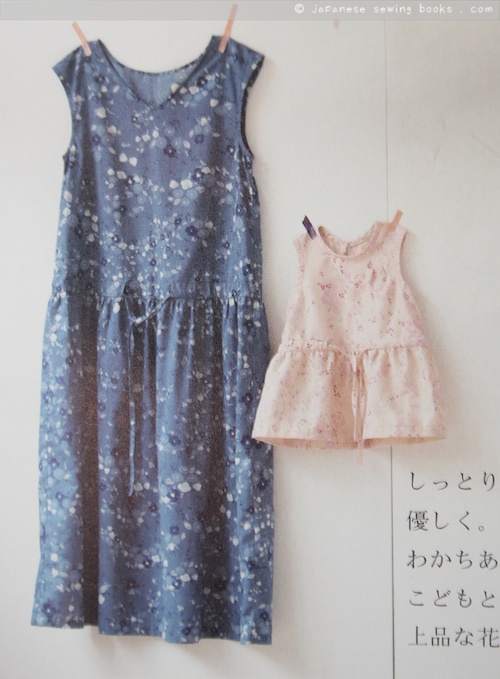Kayo Horaguchi (ホラグチ カヨ) is Japanese illustrator from Tokyo whose works involve bright colorful graphic motifs of girls, plants and animals. Her works have appeared on fabrics, books, magazines, fashion apparel, accessories, stationery etc. You can read more about her (in English) here. Or browse through her current gallery here.
I just realized, that even though my bio (on the right sidebar) says that I’m a fabric addict, I have never blogged about fabrics! Why? I’m not sure but I can always start now. Since I have on board, some new sponsors that specialize in Japanese fabrics and crafty bits. 🙂
So today, I’m starting a new category of blog posts on Japanese Fabrics. And who better to start with than one of my favourite fabric designers – Naomi Ito.
Free Japanese Sewing Pattern – UneUneGoroGoro
April 30, 2012What a cute name! Today’s blog is called UneUne GoroGoro うねうねごろごろ ( 日々をうねうね 日々をごろごろ)
Google translate tells me it means Winding Purring (Winding everyday, Purring everyday). I don’t understand winding is but I am guessing this lady likes cats? 🙂 It doesn’t matter because she makes the cutest things!
I was drawn to this site because my little one likes cats. So when I saw the little cat pouch above, I had to make one for her 🙂 The little bear is cute too, I can put in some beads and make it into a paperweight!
First of all, her website link is here http://cyocorune.cocolog-nifty.com/unegoro/ where you can see all the beautiful things she has made. She has also provided a page with links to her free patterns here – http://cyocorune.cocolog-nifty.com/unegoro/cat21754769/index.html . Some of them require you to download a PDF template. Just look out for the file extension .pdf and click on it. (See below)
The others that do not require templates are like simple bags and pouches, which are basically constructed from rectangles, so just click on the blog post and the detailed instructions will be there. I used Google translate on the how-to-make page and it gave me this. Comparing to the original Japanese Instructions :
頭用の布 7×7cm 5枚 (Cloth for head – 7x7cm 5 pieces)
耳用の布 3.5×4~5cm 2枚
ボディ用の布 7×7cm 5枚 (Cloth for body – 7x7cm 5 pieces)
3mm紐 8cm 4本 (3mm cord, 8cm long, 4pcs)
ウッドビーズ 2個(上記紐が通る物)
目鼻用ボタン(刺繍でも可)
フェルト 2.5×1.5cm 1枚
Google translate messed up the body, head and cord translations by trying to translate them into sentences and rearranging the numbers, so sometimes it might be better to use a combination of both, just to decipher the part (i.e. head/ear/body in this case) you are making, but use the dimensions from the Japanese version to avoid confusion.
The rest of the pattern is quite easy, because she has step by step photographs for some of them.
And scroll down to the bottom of the page, you will find more archived free pattern links.
Happy Sewing!
I come across many comments while surfing for Japanese Sewing Books, that Japanese patterns are very pretty, the photos in the books are gorgeous, but the results always look shapeless and sometimes pajama like?
Not true. First of all, there are books with properly fitted bodices/dresses that are not loose and airy. It’s just that they seem to like this style alot (both adults and kids) so we see them very often. Secondly, when choosing a book, you may get carried away by the pictures, but you also have to look pass the beautiful pictures and actually think about the end product. Envision on you or your child and think if its a style that suits you. If you can’t carry off cap sleeves, or A-line skirts, then don’t buy it just because it’s pretty! It is pretty much like online shopping. You can’t try it on so you have to imagine. Sometimes the best patterns are made in prints you don’t like. But don’t dismiss it yet! With a plain solid fabric or just a change in print, it could become your favourite dress!
So the reason for this post is that I believe fabric choices are very important when it comes to constructing a garment. More so for Japanese patterns. The wrong weight of fabric, or even a different type of fabric can give it a different drape and not do justice to the pattern. So I try to make the garment in the recommended fabric and once I’ve made one, I can tell if I can use a different material as a substitute. Most Japanese Sewing books do include this information, so I hope this list will be helpful to you!
レース lace
ローン lawn
リネン linen
ガーゼ gauze
ダブルガーゼ double gauze
シャンブレー chambray
ボイル voile
クレープ crepe
シルク silk
シャンタン shantung
サテン satin
タフタ tafetta
ブロード broadcloth
ギンガム gingham
ギンガムチェック gingham check
ソフトデニム soft denim
シーティング sheeting
チノクロス chino cloth
コーデュロイcorduroy
フラノ flannel
厚手デニム thick denim
帆布 canvas
持ち手テープ acrylic tape for bag handles
カツラギ katsuragi (something like twill which is thick cotton but lighter than denim)
ワッフル waffle
スウェッド suede
ジャカード jacquard
チュール tulle
Combination of words
Obviously the list is not exhaustive, but these are the more common ones I’ve come across in my books. There are also instances when they add the word 綿 in front of the fabric. The word 綿 simply means cotton. So if you see 綿ローン it means cotton lawn.
Sometimes you will see the words 無地 in front of a fabric name, this simply means that this is a solid color with no print or pattern. When you see the words プリント this means “Print” which in turns means that the fabric is printed or has a pattern.
For example,
無地サテン Solid color satin (i.e. no prints or patterns)
プリントサテン Printed Satin (i.e. with patterns)
If you come across any other words that you need to translate, you can drop me an email with a snapshot of the word, I’ll try my best!
Last updated 25th April 2015









